Best of 2014 – The Great Shohola Train Wreck
Posted By Norman Gasbarro on December 26, 2014
July 15, 2014, wass the 150th Anniversary of the Great Shohola Train Wreck. A series of posts presented here on this blog over the past year described some of the known facts and controversies regarding that disaster and also gave some personal information about some of the persons who were involved. Much new information was also presented.
Direct links (click on title) are presented here to those past blog posts.

The Great Shohola Train Wreck – Introduction to a Series of Posts
On 15 July 1864, at about 2 P.M., a train carrying 833 Confederate prisoners of war and a contingent of Union guards, collided head-on with a 50-car coal train on a single-track main line of the New York and Erie Railroad. The collision occurred about one-and-a-half miles west of the small village of Shohola, Pike County, Pennsylvania. The train carrying the prisoners was headed west from Jersey City, New Jersey, to the newly-established prison camp at Elmira, Chemung County, New York. The coal train was headed east from the Hawley branch railroad and was hauling coal from the vast anthracite coal fields of central Pennsylvania to the New York area. It was the greatest railroad disaster of the Civil War – and to that point in time, the greatest recorded railroad disaster in U.S. history. Forty-eight prisoners and seventeen Union guards were killed in the accident and many more were seriously wounded….
——————————-

The Great Shohola Train Wreck – First Newspaper Reports
[This] post is the second installment of a series on The Great Shohola Train Wreck. Some of the early newspaper accounts from Pennsylvania newspapers are presented….
—————————

The Great Shohola Train Wreck – A Local Newspaper’s Early Report
A photocopy of a fourteen-page type-script purporting to be of a newspaper article from the 22 July 1864, Tri-States Union, a Port Jervis, New York newspaper, was found among a personal collection of papers related to the Great Shohola Train Wreck. Other than the noted source (the Tri-States Union), there is no indication on the typescript as to the name of the person who transcribed it, when it was transcribed, or the purpose for which it was transcribed….
—————————–

The Great Shohola Train Wreck – Official Report of Captain Morris H. Church
The official report of the transport of prisoners to Elmira Prison Camp from Point Lookout, Maryland, including the train wreck near Shohola, Pennsylvania, was written by Captain Morris H. Church and submitted to camp commander, Col. S. Eastman on 22 July 1864….
————————————-
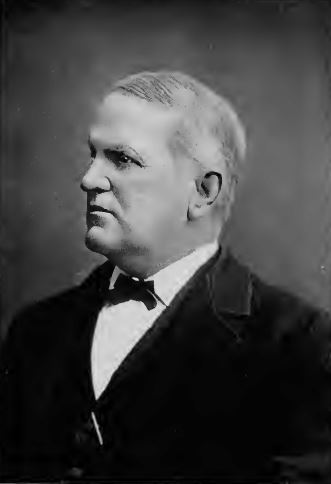
The Great Shohola Train Wreck – Preparations and Receipt of Prisoners at Elmira
In 1912, Clay W. Holmes wrote and published The Elmira Prison Camp: A History of the Military Prison at Elmira, N.Y., July 6, 1864 to July 10, 1865…. After the Great Shohola Train Wreck occurred on 15 July 1864, plans had to be made at Elmira to receive the Confederate prisoners who had survived….
—————————-

The Great Shohola Train Wreck – Fluhr’s Excellent Guide
For anyone researching and studying the Civil War Train Wreck at Shohola, one of the best places to begin is to obtain a copy of George J. Fluhr‘s The Civil War Tragedy at Shohola: A Compilation of Details Regarding the Great Prison Train Wreck at Shohola, Pennsylvania. This publication, by Pike County’s official historian, has been printed in several forms – as a stand-alone booklet or pamphlet and as part of a larger history of Shohola Township (published in 1992)…. There are later editions of this work including a greatly expanded one published in 2011, by the Shohola Railroad and Historical Society and sold by the Wayne County Historical Society, 120 pages….
—————————

The Great Shohola Train Wreck – The Geographic Context
The question of the importance of the location that Elmira, Chemung County, New York, had to the Union war effort can best be answered by examining a regional map from the time period. The above map is adapted from an 1868 railroad map and shows the major points of interest to a study of the Great Shohola Train Wreck. Railroads are shown in black lines of various thicknesses to indicate major traveled routes as well as lesser traveled routes….
—————————–
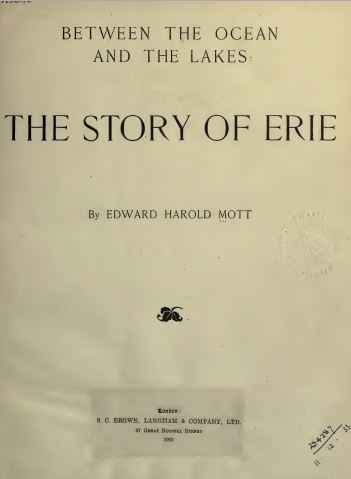
The Great Shohola Train Wreck – As Told in the History of the Erie
In the official history of the Erie Railroad, Between the Ocean and the Lakes, published in 1903, Edward Harold Mott gave a description of the accident and presented an eyewitness account, that of Frank Evans, who was identified as one of the Union guards on the train….
—————————
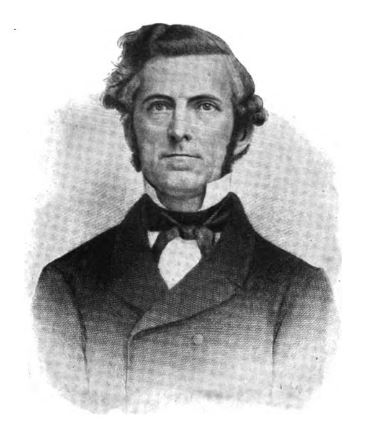
The Great Shohola Train Wreck – The Strange Coincidence of the Death of the Erie President
While it may have had nothing to do at all with the Great Shohola Train Wreck, three days after the accident, the President of the Erie Railroad died….
———————————-
The Great Shohola Train Wreck – Two Elusive Participants
In researching the participants involved in the Great Shohola Train Wreck, the one individual who supposedly allowed the coal train to enter the main line at Lackawaxen and the other individual who supposedly was a member of the Union guard on the prisoner train, have been very difficult to locate in records not associated with the collision…. Douglas “Duff” Kent has been variously described as the telegraph operator or dispatcher at Lackawaxen…. The second elusive character first appears in the Erie history, Between the Ocean and the Lakes, on page 441, as a “survivor” who gave his recollections of the train wreck… Frank Evans of New York recounted his experiences as follows….
———————————-

The Great Shohola Train Wreck – Moving the Remains from Shohola to Elmira in 1911
In 1911, the United States Government approved the removal of the bodies of the soldiers and prisoners from the site where they had been buried near King and Fuller’s Cut in Shohola Township, Pike County, Pennsylvania, to the Woodlawn National Cemetery at Elmira, New York. A vacant space was located in the cemetery and a contract was issued for a monument to be built at the site. The monument was to contain the record of the death of the soldiers, Union and Confederate, who were the victims of the train accident. Tablets would contain the names of the soldiers and the plan was to have the dedication of the monument to occur on Memorial Day 1912….
———————————–
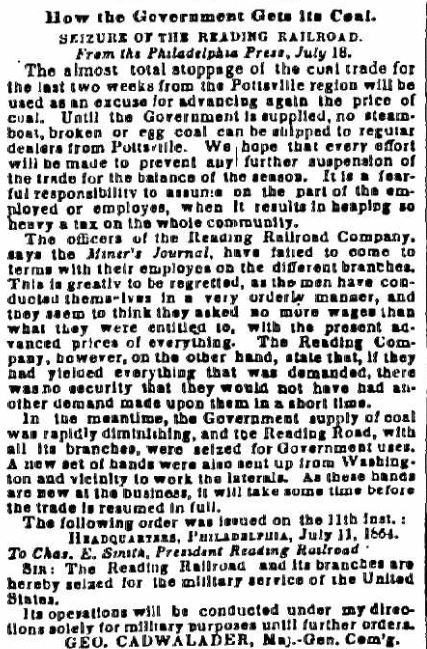
The Great Shohola Train Wreck – Was the Coal Train in a Hurry?
On the same day that the New York Times reported on the Great Shohola Train Wreck, there appeared in that newspaper on the same page and just under the train wreck report, an article telling of the government seizure of the Reading Railroad and all its branches and of the almost total stoppage of the coal trade from the Pottsville, Schuylkill County, Pennsylvania, region – which had taken place for a period two weeks prior. The New York Times article does not go into too much detail as to the reasons for the coal-flow stoppage and railroad seizure – but it is mentioned that one of the issues was the wages paid to the men and another issue was the possible forcing up of the price of coal….
———————————-
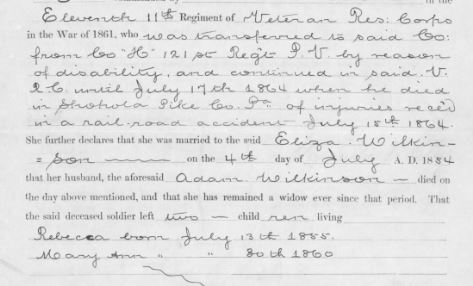
The Great Shohola Train Wreck – Adam Wilkinson, Union Guard Killed
Adam Wilkinson (1836-1864) was one of the Union soldiers who died near Shohola, Pennsylvania, in the train wreck on 15 July 1864. Prior to serving in Company F of the Veteran Reserve Corps, he had served in the 121st Pennsylvania Infantry, Company H, as a Private….
——————————
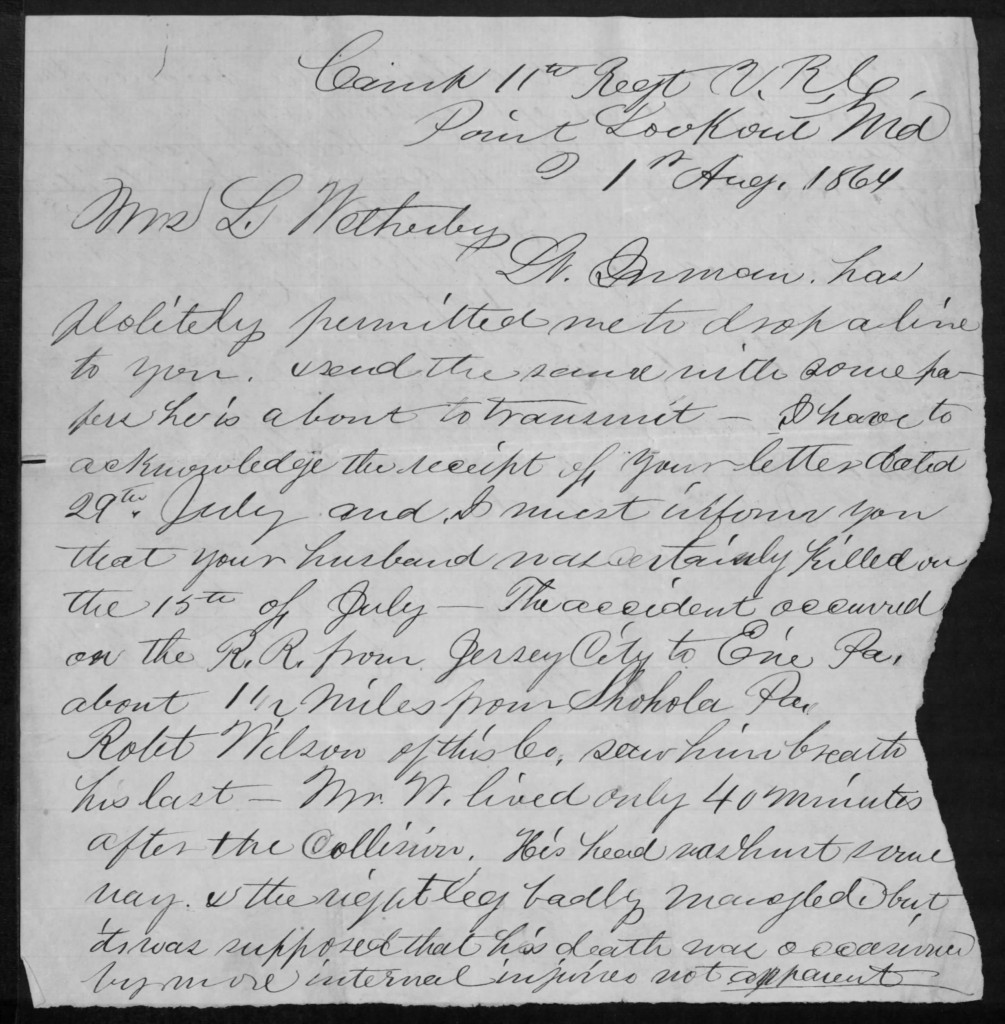
The Great Shohola Train Wreck – Lyman Weatherby, Union Guard Killed
One of the great ironies of the Great Shohola Train Wreck is that one of the Union guards who was killed, Lyman Wetherby, was from the same region of Pennsylvania where the coal train originated – the coal train that collided with the prisoner train resulting in Lyman’s death. The northern part of the anthracite mining area included Luzerne County, Pennsylvania….
———————————-
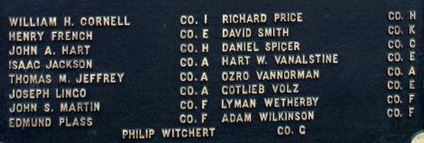
The Great Shohola Train Wreck – The Other Union Guards Who Were Killed
After the bodies of the Union guard who died at Shohola were re-interred at Elmira, New York, at the Woodlawn National Cemetery, a monument was erected with a plaque that named the 17 men who are buried there in a common grave. Previously on this blog, research was presented on two of those men, Adam Wilkinson and Lyman Wetherby, both from Pennsylvania; both served in Pennsylvania regiments prior to being transferred to the 11th Veteran Reserve Corps. Who were the other 15 men? With only preliminary research begun on them, some clues can now be given to those who wish to do further research – perhaps in their military records or pension files which are increasingly becoming available on-line….
———————————
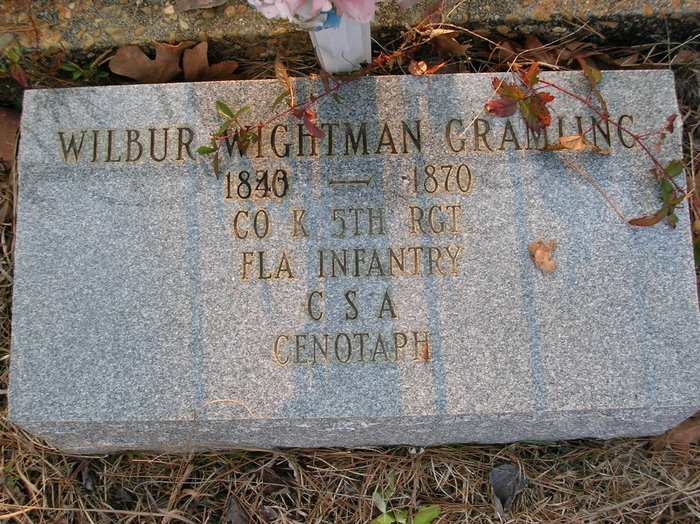
The Great Shohola Train Wreck – The Grambling Diary
Wilbur W. Grambling, a member of the 5th Florida Infantry, Company K (Confederate) arrived at Elmira Prison Camp on 24 July 1864, eight days after the arrival of the first survivors from the Great Shohola Train Wreck. Wilbur had been wounded on 6 May 1864 at the Wilderness, and because he had been sent to a hospital in a Presbyterian church in Fredericksburg, Virginia, 9 May 1864 and then later to the Columbian Hospital, Washington, D.C., on 21 May 1864, he did not travel in the usual way to Elmira Prison Camp….
—————————-
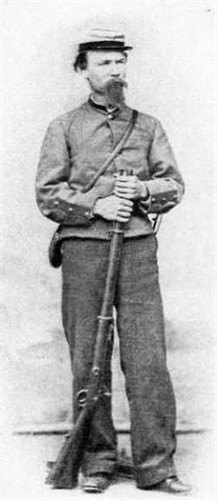
The Great Shohola Train Wreck – Sgt. Barry Benson Escapes Elmira via Millersburg
Confederate Sergeant. Barry Benson, who tunneled out of Elmira Prison. Benson, of Company H., 1st South Carolina Infantry was a prisoner of Elmira from 25 July 1864 to 7 October 1864. He had arrived at Elmira Prison via the Erie Railroad from Jersey City, ten days after the train wreck at Shohola, and was in one of the early groups of prisoners to arrive at the Union prison….
———————————-
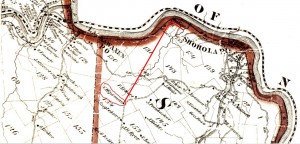
The Great Shohola Train Wreck – Valentine Hipsman, Witness to the Exhumation of Bodies in 1911
In 1911, the United States Government approved the removal of the bodies of the victims of the Great Shohola Train Wreck, Pike County, Pennsylvania, from the site of the wreck to the Woodlawn National Cemetery in Elmira, New York…. The above cut from an 1872 map of Pike County… show[s] the location of the wreck and the properties of the two local men who contributed to finding the actual burial site. In the center of the map (circled in red) is the property of “V. Hipsman” (Valentine Hipsman)….
——————————-
While no further blog posts are planned in this series, extensive genealogical information is available at the Civil War Research Project on other participants in and witnesses of the Great Shohola Train Wreck. This includes the engineers and firemen on each of the two trains, those persons in Shohola and Barryville, New York, who assisted with the care and burial of those injured in the train wreck, and on some of the Confederate prisoners who died at the scene.
As always comments are invited (add to this post or any of the posts in the series). Also, e-mails can be sent to the Civil War Research Project.
One final note. The representation of this train wreck as the worst in history as of July 1864 is apparently incorrect.


Events of the World: June 1864
The Grand Turk Railway accident known as the St-Hilaire train disaster was a railroad disaster that occurred on 29 June 1864, near the present day town of Mont-Saint-Hilaire, Quebec… Though uncertain, the widely accepted death toll is 99 persons.The disaster remains the worst railway accident in Canadian history.
————————————-
EPILOGUE:
More on Valentine Hipsman

Jane Butler of Minisink Valley Genealogy, has called my attention to a blog post she published this month on Valentine Hipsman, who I had previously profiled here in June as part of my series on “The Great Shohola Train Wreck.” [ShoholaTrainWreck].
Jane’s post is entitled; The Hubschmann Monument, Hipsman Burying Ground, Shohola, PA. It pictures the grave markers of members of the Hipsman/Hubschmann family that surround the monument in what is now German Hill Cemetery in Shohola Township, Pike County, Pennsylvania. There is also a much more extensive biographical profile of Valentine Hipsman than I provided in my June post.
For a link to the series on the train wreck, see: The Great Shohola Train Wreck – The 150th Anniversary Remembrance.
——————————
Image sources can be found in the blog posts which can be accessed by clicking on the post titles (above).
 ;
;


Comments